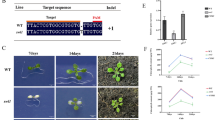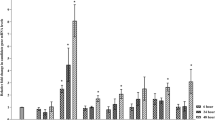Abstract
Main conclusion
Tomato leaf curl New Delhi virus-derived AC4 protein interacts with host proteins involved in auxin biosynthesis and reprograms auxin biosynthesis/signaling to help in viral replication and manifestation of the disease-associated symptoms.
Abstract
Perturbations of phytohormone-mediated gene regulatory network cause growth and developmental defects. Furthermore, plant viral infections cause characteristic disease symptoms similar to hormone-deficient mutants. Tomato leaf curl New Delhi Virus (ToLCNDV)-encoded AC4 is a small protein that attenuates the host transcriptional gene silencing, and aggravated disease severity in tomato is correlated with transcript abundance of AC4. Hence, investigating the role of AC4 in pathogenesis divulged that ToLCNDV-AC4 interacted with host TAR1 (tryptophan amino transferase 1)-like protein, CYP450 monooxygenase—the key enzyme of indole acetic acid (IAA) biosynthesis pathway—and with a protein encoded by senescence-associated gene involved in jasmonic acid pathway. Also, ToLCNDV infection resulted in the upregulation of host miRNAs, viz., miR164, miR167, miR393 and miR319 involved in auxin signaling and leaf morphogenesis concomitant with the decline in endogenous IAA levels. Ectopic overexpression of ToLCNDV-derived AC4 in tomato recapitulated the transcriptomic and disruption of auxin biosynthesis/signaling features of the infected leaves. Furthermore, exogenous foliar application of IAA caused remission of the characteristic disease-related symptoms in tomato. The roles of ToLCNDV-AC4 in reprogramming auxin biosynthesis, signaling and cross-talk with JA pathway to help viral replication and manifest the disease-associated symptoms during ToLCNDV infection are discussed.







Similar content being viewed by others
References
Bazzini AA, Hopp HE, Beachy RN, Asurmendi S (2007) Infection and co-accumulation of tobacco mosaic virus proteins alter microRNA levels, correlating with symptom and plant development. Proc Natl Acad Sci USA 104:12157–12162
Benjamins R, Scheres B (2008) Auxin: the looping star in plant development. Annu Rev Plant Biol 59:443–465
Carluccio AV, Prigigallo MI, Rosas-Diaz T, Lozano-Duran R, Stavolone L (2018) S-acylation mediates Mung bean yellow mosaic virus AC4 localization to the plasma membrane and in turns gene silencing suppression. PLoS Pathog 14:1007207
Chandler JW (2016) Auxin response factors. Plant Cell Environ 39:1014–1028
Chen K, Khatabi B, Fondong VN (2019) The AC4 protein of a cassava geminivirus is required for virus infection. Mol Plant Microbe Interact 32(7):865–875. https://doi.org/10.1094/mpmi-12-18-0354-r
Cheng Y, Dai X, Zhao Y (2006) Auxin biosynthesis by the YUCCA flavin monooxygenases controls the formation of floral organs and vascular tissues in Arabidopsis. Genes Dev 20:1790–1799
Floková K, Tarkowská D, Miersch O, Strnad M, Wasternack C, Novák O (2014) UHPLC-MS/MS based target profiling of stress-induced phytohormones. Phytochemistry 105:147–157
Fondong VN (2019) The ever-expanding role of C4/AC4 in geminivirus infection: Punching above its weight? Mol Plant 12:145–147
Hipp K, Rau P, Schäfer B, Pfannstiel J, Jeske H (2016) Translation, modification and cellular distribution of two AC4 variants of African cassava mosaic virus in yeast and their pathogenic potential in plants. Virology 498:136–148
Islam W, Qasim M, Noman A, Adnan M, Tayyab M, Farooq TH, Wei H, Wang L (2018) Plant microRNAs: front line players against invading pathogens. Microb Pathog Internet 118:9–17
Jin L, Qin Q, Wang Y, Pu Y, Liu L, Wen X, Ji S, Wu J, Wei C, Ding B, Li Y (2016) Rice dwarf virus P2 protein hijacks auxin signaling by directly targeting the rice OsIAA10 protein, enhancing viral infection and disease development. PLoS Pathog 12(9):e1005847
Jyothsna P, Haq QMI, Singh P, Sumiya KV, Praveen S, Rawat R, Briddon RW, Malathi VG (2013) Infection of tomato leaf curl New Delhi virus (ToLCNDV), a bipartite begomovirus with betasatellites, results in enhanced level of helper virus components and antagonistic interaction between DNA B and betasatellites. Appl Microbiol Biotechnol 97:5457–5471
Kasschau KD, Xie Z, Allen E, Llave C, Chapman EJ, Krizan KA, Carrington JC (2003) P1/HC-Pro, a viral suppressor of RNA silencing, interferes with Arabidopsis development and miRNA function. Dev Cell 4:205–217
Koyama T, Mitsuda N, Seki M, Shinozaki K, Ohme-Takagi M (2010) TCP transcription factors regulate the activities of ASYMMETRIC LEAVES1 and miR164, as well as the auxin response, during differentiation of leaves in Arabidopsis. Plant Cell 22:3574–3588
Lang QL, Zhou XC, Zhang XL, Drabek R, Zuo ZX, Ren YL et al (2011) Microarray-based identification of tomato microRNAs and time course analysis of their response to Cucumber mosaic virus infection. J Zhejiang Univ Sci B 12(2):116–125
Li SB, Xie ZZ, Hu CG, Zhang JZ (2016) A review of auxin response factors (ARFs) in plants. Front Plant Sci 7:47
Li H, Zeng R, Chen Z, Liu X, Cao Z, Xie Q, Yang C, Lai J (2019) S-acylation of a geminivirus C4 protein is essential for regulating the CLAVATA pathway in symptom determination. J Exp Bot 69:4459–4468
Lopez JA, Sun Y, Blair PB, Mukhtar MS (2015) TCP three-way handshake: linking developmental processes with plant immunity. Trends in Plant Sci 20:238–245
Ludwig-Muller J (2011) Auxin conjugates: their role for plant development and in the evolution of land plants. J Exp Bot 62:1757–1773
Martín-Trillo M, Cubas P (2010) TCP genes: a family snapshot ten years later. Trends Plant Sci 15:31–39
Mashiguchi K, Tanaka K, Sakai T, Sugawara S, Kawaide H, Natsume M, Hanada A, Yaeno T, Shirasu K, Yao H, McSteen P (2011) The main auxin biosynthesis pathway in Arabidopsis. Proc Natl Acad Sci USA 108:18512–18517
Mei Y, Wang Y, Hu T, Yang X, Lozano-Duran R, Sunter G, Zhou X (2018a) Nucleocytoplasmic shuttling of geminivirus C4 protein mediated by phosphorylation and myristoylation is critical for viral pathogenicity. Mol Plant 11:1466–1481
Mei Y, Yang X, Huang C, Zhang X, Zhou X (2018b) Tomato leaf curl Yunnan virus-encoded C4 induces cell division through enhancing stability of Cyclin D 1.1 via impairing NbSKη-mediated phosphorylation in Nicotiana benthamiana. PLoS Pathog 14(1):e1006789. https://doi.org/10.1371/journal.ppat.1006789
Mills-Lujan K, Deom CM (2010) Geminivirus C4 protein alters Arabidopsis development. Protoplasma 239:95–110
Padmanabhan MS, Kramer SR, Wang X, Culver JN (2008) Tobacco mosaic virus replicase-auxin/indole acetic acid protein interactions: reprogramming the auxin response pathway to enhance virus infection. J Virol 82(5):2477–2485
Palatnik JF, Allen E, Wu X, Schommer C, Schwab R, Carrington JC, Weigel D (2003) Control of leaf morphogenesis by microRNAs. Nature 425:257–263
Paque S, Weijers D (2016) Q&A: Auxin: the plant molecule that influences almost anything. BMC Biol 14:67
Piroux N, Saunders K, Page A, Stanley J (2007) Geminivirus pathogenicity protein c4 interacts with Arabidopsis thaliana shaggy-related protein kinase AtSKeta, a component of the brassinosteroid signaling pathway. Virol 362:428–440
Praveen S, Ramesh SV, Mishra AK, Koundal V, Palukaitis P (2010) Silencing potential of viral derived RNAi constructs in Tomato leaf curl virus-AC4 gene suppression in tomato. Transgenic Res 19:45–55
Qi L, Yan J, Li Y, Jiang H, Sun J, Chen Q, Li H, Chu J, Yan C, Sun X, Yu Y (2012) Arabidopsis thaliana plants differentially modulate auxin biosynthesis and transport during defense responses to the necrotrophic pathogen Alternaria brassicicola. New Phytol 195:872–882
Ramesh SV, Mishra AK, Praveen S (2007) Hairpin RNA-mediated strategies for silencing of tomato leaf curl virus AC1 and AC4 genes for effective resistance in plants. Oligonucleotides 17:251–257
Rosas-Diaz T, Zhang D, Fan P, Wang L, Ding X, Jiang Y, Jimenez-Gongora T, Medina-Puche L, Zhao X, Feng Z, Zhang G (2018) A virus-targeted plant receptor-like kinase promotes cell-to-cell spread of RNAi. Proc Natl Acad Sci USA 115:1388–1393
Schommer C, Palatnik JF, Aggarwal P, Chételat A, Cubas P, Farmer EE, Nath U, Weigel D (2008) Control of jasmonate biosynthesis and senescence by miR319 targets. PLoS Biol 6:e230
Stepanova AN, Robertson-Hoyt J, Yun J, Benavente LM, Xie DY, Doležal K, Schlereth A, Jürgens G, Alonso JM (2008) TAA1-mediated auxin biosynthesis is essential for hormone crosstalk and plant development. Cell 133:177–191
Tagami Y, Inaba N, Kutsuna N, Kurihara Y, Watanabe Y (2007) Specific enrichment of miRNAs in Arabidopsis thaliana infected with Tobacco mosaic virus. DNA Res 14:227–233
Teng K, Chen H, Lai J, Zhang Z, Fang Y, Xia R, Zhou X, Guo H, Xie Q (2019) Involvement of C4 protein of Beet severe curly top virus (Family Geminiviridae) in virus movement. PLoS ONE 5(6):e11280
Vinutha T, Kumar G, Garg V, Canto T, Palukaitis P, Ramesh SV, Praveen S (2018) Tomato geminivirus encoded RNAi suppressor protein, AC4 interacts with host AGO4 and precludes viral DNA methylation. Gene 678:184–195
Weijers D, Wagner D (2016) Transcriptional responses to the auxin hormone. Annu Rev Plant Biol 67:539–574
Wieczorek P, Wrzesińska B, Obrępalska-Stęplowska A (2013) Assessment of reference gene stability influenced by extremely divergent disease symptoms in Solanum lycopersicum L. J Virol Methods 194:161–168
Wu L, Luo P, Di DW, Wang L, Wang M, Lu CK, Wei SD, Zhang L, Zhang TZ, Amakorová P, Strnad M (2015) Forward genetic screen for auxin-deficient mutants by cytokinin. Sci Rep 5:11923. https://doi.org/10.1038/srep11923
Zeng R, Liu X, Yang C, Lai J (2018) Geminivirus C4: interplaying with receptor-like kinases. Trends Plant Sci 23:1044–1046
Zhang Y, Friml J (2019) Auxin guides roots to avoid obstacles during gravitropic growth. New Phytol 225(3):1049. https://doi.org/10.1111/nph.16203
Zhao Y (2014) Auxin biosynthesis. Arabidopsis Book 12:e0173. https://doi.org/10.1199/tab.0173
Zhao Y, Hull AK, Gupta NR, Goss KA, Alonso J, Ecker JR, Normanly J, Chory J, Celenza J (2002) Trp-dependent auxin biosynthesis in Arabidopsis: involvement of cytochrome P450s CYP79B2 and CYP79B3. Genes Dev 16:3100–3112
Zhu S, Gao F, Cao X, Chen M, Ye G, Wei C, Li Y (2005) The rice dwarf virus P2 protein interacts with ent-kaurene oxidases in vivo, leading to reduced biosynthesis of gibberellins and rice dwarf symptoms. Plant Physiol 139(4):1935–1945
Acknowledgements
The authors gratefully acknowledge the financial support from ICAR-IARI for this work.
Funding
This work was supported by the Indian Council of Agricultural Research-Indian Agricultural Research Institute, New Delhi, India.
Author information
Authors and Affiliations
Corresponding authors
Ethics declarations
Conflict of interest
The authors wish to state that no conflicts of interest exist.
Additional information
Communicated by Anastasios Melis.
Publisher's Note
Springer Nature remains neutral with regard to jurisdictional claims in published maps and institutional affiliations.
Rights and permissions
About this article
Cite this article
Vinutha, T., Vanchinathan, S., Bansal, N. et al. Tomato auxin biosynthesis/signaling is reprogrammed by the geminivirus to enhance its pathogenicity. Planta 252, 51 (2020). https://doi.org/10.1007/s00425-020-03452-9
Received:
Accepted:
Published:
DOI: https://doi.org/10.1007/s00425-020-03452-9




